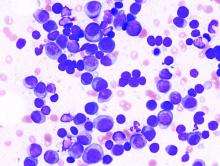Busulfan plus melphalan could replace melphalan alone as the standard conditioning regimen for multiple myeloma patients undergoing autologous hematopoietic cell transplant, according to researchers.
In a phase 3 trial, patients who received conditioning with busulfan plus melphalan had significantly longer median progression-free survival compared with patients who received melphalan alone – 64.7 months versus 43.5 months (P = .022).
However, there was no overall survival advantage with busulfan plus melphalan, and adverse events were more common with this regimen, reported Qaiser Bashir, MD, of the University of Texas MD Anderson Cancer Center in Houston, and his colleagues. The report is in The Lancet Haematology.
To their knowledge, the researchers wrote, this was the first randomized, phase 3 trial showing a significant progression-free survival benefit for busulfan plus melphalan versus the standard of care of melphalan 200 mg/m2 pretransplantation conditioning. “These data suggest that busulfan plus melphalan conditioning can serve as a useful platform for further improvement of transplant outcomes in patients with myeloma.”
The current trial (NCT01413178) enrolled 205 multiple myeloma patients who were eligible for transplant. They were randomized to conditioning with melphalan alone or busulfan plus melphalan.
In all, 98 patients received melphalan alone, given at 200 mg/m2 on day –2. The 104 patients who received busulfan plus melphalan started with a test dose of busulfan at 32 mg/m2, which was followed by pharmacokinetically adjusted doses on days –7, –6, –5, and –4 to achieve a target daily area under the curve of 5,000 mmol/minute. These patients received melphalan at 70 mg/m2 per day on days –2 and –1.
The median age at transplant was 57.9 years (range, 31.7-70.9 years) in the busulfan group and 57.6 years (range, 34.3-70.6 years) in the melphalan-alone group.
The most common induction regimen used was bortezomib, lenalidomide, and dexamethasone, which was given to 60% of the busulfan group and 57% of the melphalan-alone group.
Most patients responded to induction – 96% of patients in the busulfan group and 94% of those in the melphalan-alone group.
There was no treatment-related mortality within 100 days of transplant.
At 90 days after transplant, the response rate was 98% in the busulfan group and 97% in the melphalan-alone group. The rate of complete remission/stringent complete remission was 27% and 34%, respectively.
Most patients received posttransplant maintenance. The most common maintenance regimen consisted of lenalidomide monotherapy, which was given to 57% of the busulfan group and 58% of the melphalan-alone group.
Patients continued maintenance until disease progression or unacceptable toxicity. The median duration of maintenance was 16.0 months in the busulfan group and 10.1 months in the melphalan-alone group.
The median follow-up was 22.6 months in the busulfan group and 20.2 months in the melphalan-alone group.
Progression-free survival was superior in the busulfan group. Median progression-free survival was 64.7 months in the busulfan group and 43.5 months in the melphalan-alone group (hazard ratio = 0.53; P = .022). The 3-year progression-free survival rate was 72% and 50%, respectively.
The median overall survival was not reached in either group. The 3-year overall survival rate was 91% in the busulfan group and 89% in the melphalan-alone group.
There were 10 deaths in the busulfan group, 7 due to progression and 3 due to infection. All 7 deaths in the melphalan-alone group were due to progression.
Grade 3-4 nonhematologic toxicity was more common in the busulfan group, occurring in 84% of that group and 33% of the melphalan-alone group (P less than .0001).
Grade 2-3 mucositis occurred in 74% of the busulfan group and 14% of the melphalan-alone group. There were no cases of grade 4 mucositis.
One patient in the busulfan group had grade 4 cardiac toxicity, an acute myocardial infarction, and ventricular fibrillation. However, the patient recovered and was in remission at last follow-up.
Two patients in the busulfan group developed second primary malignancies. One patient developed squamous cell skin cancer and rectal adenocarcinoma, and the other developed melanoma and basal cell skin carcinoma.
Three patients in the melphalan-alone group developed second primary malignancies. Two patients had squamous cell skin cancers and one had myelodysplastic syndrome.
Dr. Bashir and his colleagues noted that this study has limitations, including insufficient data to assess minimal residual disease and its impact on survival. It is a single-center study and induction and maintenance therapies were not prespecified.
“These results should be verified in a cooperative group or a multicenter, randomized study to assess the generalizability of our findings,” the researchers wrote.
Dr. Bashir and his colleagues reported having no competing financial interests. The trial was sponsored by MD Anderson Cancer Center in collaboration with Otsuka Pharmaceutical Development & Commercialization. The work was funded in part by the National Institutes of Health.
SOURCE: Bashir Q et al. Lancet Haematol. 2019 Mar 22. doi: 10.1016/S2352-3026(19)30023-7.


